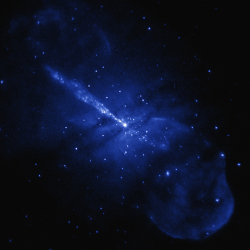HEAPOW: The Sword of the Centaur (2023 May 22)
Posted: Thu Jun 08, 2023 12:29 am
 The Sword of the Centaur
The Sword of the Centaur
One of the most mysterious and beautiful galaxies is Centaurus A. Cen A was discovered August 4, 1826 by James Dunlop at the Parramatta observatory in Australia. It first arose to prominence due to its strong radio emission, discovered in the middle of the twentieth century. This galaxy, a hybrid like the creatures that gave name to its constellation, is cut in two by thick lanes of dust. It turns out that Cen A has swallowed up a spiral galaxy, and harbors a supermassive black hole at its center to boot. This black hole is feeding actively and messily, gobbling up nearby material that spirals into its voracious maw. The image above shows a Chandra X-ray Observatory false-color, high-resolution image of Centaurus A. The X-rays are produced by high-energy processes, and the Chandra image helps us get a census of these processes in Cen A and other active galaxies like it. The Chandra image reveals X-ray emission from diffuse, hot, high energy particles surrounding the galaxy, and the dust lanes near the center of the galaxy which are so thick not even X-rays can penetrate through them. Most notably, the Chandra image shows a narrow, high energy particle beam from the black hole at the center (itself a bright, unresolved source of X-ray emission) blasting into space towards the upper left of the image, extending over 13,000 lightyears.
CXC: Centaurus A Shines in New Image from Chandra and IXPE
viewtopic.php?t=43103
| << Previous HEAPOW | High Energy Astrophysics Picture of the Week | Next HEAPOW >> |